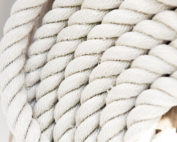Titanium dioxide pigments are manufactured on the industrial scale by two manufacturing methods: sulphate method (used since the 20’s of the 20th century), and a newer one – chloride method (since the 50’s of the previous century). The names of the methods come from the names of salts, from which titanium dioxide (TiO2) is obtained. In the sulphate method, TiO2 is obtained from the aqueous solution of titanyl sulphate in precipitation process. On the contrary, in the chloride method, titanium dioxide is obtained at high temperatures from gaseous titanium chloride through oxidation process with use of pure oxygen. Both methods make use of two basic titanium-bearing raw materials: ilmenite and titanium slag. Technological differences between the used technologies and variety of raw materials result in essential differences in the properties of obtained pigments. Therefore, nowadays on the market approximately 400 grades of titanium dioxide are present, which are manufactured by tens of companies. These grades differ in manufacturing technologies, crystallographic forms, type of surface treatment, and mainly in their properties and application areas.
Both methods of manufacturing of titanium dioxide have got disadvantages and advantages attributed to them. The older sulphate method enables manufacturing of both types: anatase and rutile and semi-finished products for manufacturing of ultra-fine titanium dioxide. Unfortunately, it is burdened with greater amount of waste, which is of greater impact on the environment, and the pigment itself has got a bit lower brightness. On the other hand, the newer more technically advanced chloride method enables manufacturing of rutile grades only. It is less noxious to the environment, but it is accompanied by risk of uncontrolled emission of gaseous chlorine into the environment.
In the recent years the “sulphate” manufacturers of titanium dioxide have dealt successfully with the problem of management of two key waste products. Copperas – from being a waste – has turned into a valued semi-finished product (for manufacturing of coagulants for sewage and water treatment, for manufacturing of ferric pigments or as a reducing agent in the cement industry), and the waste sulphuric acid is concentrated and recycled to the production process of titanium dioxide or used for manufacturing of phosphoric acid (like at Z.Ch. „POLICE” SA). Pro-ecological investments made in the past decade (systems of sulphur removal from post-digestion and post-calcination gases) adapting the systems to the EU requirements have drastically reduced their negative impact on the environment. Additionally, emergence of manufacturing technology of ultra-fine titanium dioxide has opened completely new prospects for the sulphate installations.
All the above factors increase the attractiveness of sulphate installations, still allowing them for efficient competition with the chloride installations.
KNOWLEDGE BASE
TITANIUM DIOXIDE – application
Titanium dioxide, known as titanium white, is the most important and most widespread inorganic pigment. It is used in a wide range of products we use every day, giving them appropriate apperance: the color, opacity [...]
Where to find TiO2 in daily life?
Titanium dioxide, also known as TiO2, is one of the most common pigments and is used as a basis for all colours, to give the brightness to paints, printing inks, paper, plastic products, foods, cosmetics, [...]



